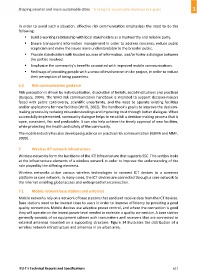Page 627 - Shaping smarter and more sustainable cities - Striving for sustainable development goals
P. 627
In order to avoid such a situation, effective risk communication emphasizes the need to do the
following:
Build a working relationship with local stakeholders as a trustworthy and reliable party.
Ensure transparent information management in order to address concerns, reduce public
scepticism and make the issues more understandable to the broader public.
Provide stakeholders with trusted sources of information, and/or foster a dialogue between
the parties involved.
Emphasize the community’s benefits associated with improved mobile communications.
Find ways of providing people with a sense of involvement in the project, in order to reduce
their perception of being powerless.
6.3 Risk communication guidance
Risk perception is driven by individualization, dissolution of beliefs, social institutions and practices
(Burgess, 2004). The WHO risk communication handbook is intended to support decision‐makers
faced with public controversy, scientific uncertainty, and the need to operate existing facilities
and/or applications for new facilities (WHO, 2002). The handbook’s goal is to improve the decision‐
making process by reducing misunderstandings and improving trust through better dialogue. When
successfully implemented, community dialogue helps to establish a decision‐making process that is
open, consistent, fair and predictable. It can also help achieve the timely approval of new facilities,
while protecting the health and safety of the community.
The mobile industry has also developed guidance on practical risk communication (GSMA and MMF,
2009).
7 Wireless ICT network infrastructure
Wireless networks form the backbone of the ICT infrastructure that supports SSC. This section looks
at the infrastructure elements of a wireless network in order to improve the understanding of the
role played by the differing elements.
Wireless networks utilize various wireless technologies to connect ICT devices to a common
platform or core network. In many cases, the ICT devices are connected through a core network to
the Internet enabling global access and widespread interconnection.
7.1 Mobile network base stations and antennas
Mobile networks rely on a network of base stations that send and receive data from the ICT devices.
Base stations need to be located close to users in order to improve efficiency by providing a good
quality connection. Mobile devices use adaptive power control, and where the connection is good
they will operate on the lowest power level needed to maintain a quality connection. A base station
generally consists of an equipment cabinet with transmitters and receivers that are connected to
external antennas mounted on a supporting structure. Figure 14 illustrates the distribution of a
wireless network infrastructure and antennas in an urban area.
ITU‐T's Technical Reports and Specifications 617

